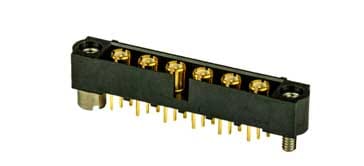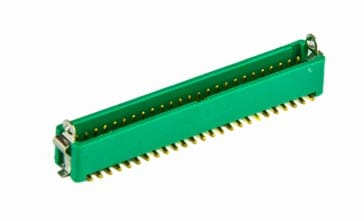Electrical / Electronic Connector Basics
Electrical / electronic connectors are used to connect wires and cables in electrical and electronic circuit designs and they are a key electronic component in all designs.
Home » Electronic components » this page
Connector Technology Includes:
Connector basics
Connector types
Specifications
Selecting the right connector
D-type connector
IEC power connector
Jack connector
XLR connector
IDC connector
PCB edge connector
DIN 41612 connector
Connectors are used in virtually every item of electronic equipment, in electronic designs of all forms. Connectors are also widely used within the electrical industry as well.
Millions of connectors of all types are manufactured and used each week, making them one of the most widely used electronic components.

Connectors are used where wires lines need to be connected and disconnected and therefore using a connector provides a huge amount of flexibility. Electronic circuit boards, i.e. printed circuit boards can be assembled and tested. When they are complete they can be quickly connected into the final unit or system.
Electronic equipment can be easily connected to other items of equipment to make a system and so forth. Connectors are an electronic component that is often dismissed as having less importance, but in reality they are absolutely key to any electronic design.
Connector basics
The concept of a connector is that it is a conductor that can be easily mechanically connected and disconnected to allow the physical separation of one circuit from another.
The physical attributes of an electrical or electronic connector can take many forms. Some or large, others a small. They may have a single or multiple connections and they can take many shapes and they are of a variety of different sizes.
Some connectors may be manufactured bya single supplier, whereas others may be industry standard and widely seen and used. The application will generally determine the type of connector and its attributes.
Although the basic concept of connectors is relatively straightforward, there are some features about connectors that are useful to define before moving on.
- Gender: Connectors are referred to as being male and female types. The female connector is generally a receptacle that receives and holds the "male" connector. The male connector has the pins that enter the female side of the connector.
- Orientation: It is essential that connectors are plugged together with the correct orientation. Although some two pin connectors may be able to be plugged in either way, in most instances ensuring the correct contacts mate is essential to make sure the right connections are made.
Strain relief: One of the issues with connectors that have cables or wires entering them is that the connections to the pins can be fragile. If the cable is pulled or the connections are strained in any way the connections of the wire to the connector can break.
To help overcome this, the cable entering the connector can be clamped so that once inside the connector there is no movement and the joints between the cable and the connector contacts remain intact through the life of the connector, thereby considerably improving the reliability.

Connector circuit symbols
Connectors are represented within the schematic circuit diagrams of electronic circuit designs in a number of ways.
Normally the symbols are quite obvious, but dependent upon the actual system used, the notations used for the connector circuit symbols may vary slightly.


In addition to the basic contact symbols used for the connections themselves, the overall connector circuit symbol os often bounded by a line or box to show that the connections are all within the same connector package.
Key connector topics
Connector technology has developed a long way and as a result there are numerous connector topics that are of importance.
Connector types: Connectors are used in huge number of different areas where they have a large variety of different requirements. As a result there are many different types on connector: circular, straight, those for PCBs, RF connectors and many more.
As might be expected there are many series of popular connector formats that are used in vast quantities. Connectors like jack or phone connectors, IDS connectors, XLR connectors, D-type and many more.
Read more about . . . . Connector Types.
- Connector specifications: When selecting a connector it is very useful to be able to understand the various specifications and how they affect performance. In any connector datasheet there is a lot of different parameters quoted. Understanding which ones are important and how they affect the performance of the particular circuit or application is key to selecting the right connector.
Read more about . . . . Connector Specifications.
How to select & buy the right connector: Even when understanding connector specifications and parameters, it can sometimes be difficult to come to a decision about the best option to select as there are so many from which to choose.
Having a methodology to follow can help narrow down the field so that the best connector is selected.
Read more about . . . . How to Select the Right Connector.

Connectors perform a very valuable function in any electronic circuit design. Their operation can govern many aspects of the performance of a circuit, and their reliability is of paramount importance. Poor contacts, or connectors that become loose can cause a unit to fail. However connector technology is now such that high levels of reliability can be obtained.
 Written by Ian Poole .
Written by Ian Poole .
Experienced electronics engineer and author.
More Electronic Components:
Batteries
Capacitors
Connectors
ADC
DAC
Diodes
FET
Inductors
Memory types
Phototransistor
Quartz crystals
Relays
Resistors
RF connectors
Switches
Surface mount technology
Thyristor
Transformers
Transistor
Unijunction
Valves / Tubes
Return to Components menu . . .


